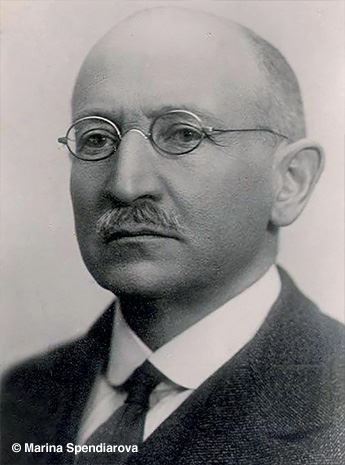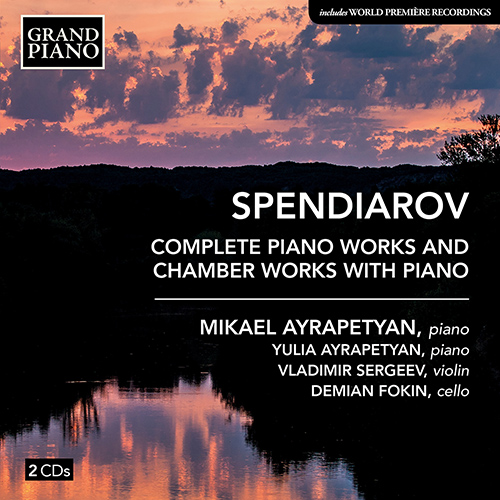
Alexander Spendiarian (1871 - 1928)
Russian and Armenian musical elements are successfully combined in the music of Alexander Spendiarov. An apprentice of Rimsky-Korsakov and a close friend of Glazunov, Spendiarov was a master orchestrator and an inventive instrumentalist whose music is saturated with the folk music of the region and boundless lyricism. His works undoubtedly reflect the creative assimilations and traditions of the Russian classical music school, and above all, that of Rimsky-Korsakov. He expanded the ideological and thematic range of Armenian music, and enriched its means of expression by raising the level of musical professionalism in Armenia.
Alexander Afanasyevich Spendiarov (also known as Spendiarian) was born on 1 November 1871 in the town of Kakhovka (now a city in the Kherson region of Ukraine). He spent his childhood in Simferopol, and inherited his musical abilities from his mother who played the piano. Spendiarov’s many talents were evident in early childhood, but a predominant interest in music began to emerge. At the age of seven he began to compose, and at the age of nine he began to study piano and violin.
‘Of the musical influences during my infancy and adolescence’, Spendiarov recalled, ‘the strongest was my mother’s piano playing, whom I loved to listen to and which undoubtedly awakened my early love for music.’
In 1890, Spendiarov entered Moscow University, studying at the Department of Law while at the same time studying the violin and playing in the student orchestra. He took lessons in theory and composition from the orchestra’s conductor, and after graduating from university in 1896 went to St Petersburg where, for four years, he studied composition with Rimsky-Korsakov. During his studies, Spendiarov wrote a number of vocal and instrumental pieces which immediately gained popularity. Among them are the romances To the Rose and Eastern Lullaby, and the Concert Overture (1900). During this period, Spendiarov met Glazunov, Liadov and Tigranian, with whom he formed long lasting friendships.
From 1900, Spendiarov lived mainly in Crimea (Yalta, Feodosia and Sudak) and started communicating with some of the most prominent representatives of Russian artistic culture including Maxim Gorky, Anton Chekhov, Leo Tolstoy, Ivan Bunin, Feodor Chaliapin and Rachmaninov.
In 1902, while in Yalta, Maxim Gorky introduced Spendiarov to his poem The Fisherman and the Fairy and suggested that the text be set to music. This ballad for bass with orchestra, first performed by Chaliapin that summer, became one of the composer’s best-loved works.
In 1910, Spendiarov composed Edelweiss based on texts from Gorky’s play Summerfolk, thereby expressing his political views as a revolutionary. After the events of Bloody Sunday on 9 January 1905, which prompted Rimsky-Korsakov to declare his outrage at the senseless killing of unarmed protesters – subsequently leading to his dismissal from the St Petersburg Conservatory – it remains characteristic that in 1905 Spendiarov wrote an open letter that appeared in newspapers protesting the discharge of Rimsky-Korsakov from his role.
The folk music of the peoples of Crimea, especially the Armenians and the Crimean Tatars, permeates Spendiarov’s music. The authentic melodies of the Crimean Tatars were used in one of the composer’s best-known works – the two series of Crimean Sketches for orchestra (1903, 1905). On the initiative of César Cui, Spendiarov’s debut as a conductor took place in Yalta in the summer of 1903 – it was a performance of the first series of Crimean Sketches. Spendiarov subsequently conducted widely throughout Russia and the Caucasus.
At the start of the First World War, Spendiarov composed the heroic song There, there, on the field of honour, based on the novel Wounds of Armenia by Khachatur Abovian. The cover of the published score was designed by the great Armenian painter Martiros Sarian, and began a long-standing friendship between these two distinctive representatives of Armenian culture. Together, they donated the proceeds from the publication to the Committee for Aid to the Victims of the War in Turkey.
To commemorate the victims of the Armenian Genocide, Spendiarov composed the heroic-patriotic aria for baritone and orchestra Towards Armenia, with a text by Hovhannes Hovhannisyan. This significant work paved the way for the creation of the opera Almast based on Hovhaness Tumanian’s poem The Capture of Tmkabert, which tells the story of the Armenian people’s struggle for liberation against Persian conquerors in the 18th century. Martiros Sarian introduced Spendiarov to the poem and a libretto was written by the Russian poet and journalist Sophia Parnok. In preparation for this composition, Spendiarov began to accumulate Armenian and Persian folk and ashugh tunes, and acquired various examples of oriental music.
In Sudak, Crimea, during 1923, Spendiarov worked at the department of public education, directing amateur choirs and orchestras, and transcribing Russian and Ukrainian folk songs. He also resumed his activities as a conductor in Crimea, Moscow and Leningrad. In a concert held in the Great Hall of the Leningrad Philharmonic on 5 December 1923, the second series of Crimean Sketches, the Lullaby, the first suite from the opera Almast (a selection of symphonic excerpts that would later be included in the opera) and the symphonic picture Three Palms were performed for the first time, which garnered a favourable response from music critics. Work on Almast was finally completed in 1928 after the composer’s move to Yerevan at the invitation of the government of Soviet Armenia in 1924.
Moving to Yerevan had a significant impact on Spendiarov’s creative activities. He taught at the Conservatory, and participated in the organisation of the first symphony orchestra in Armenia, while continuing his activities as a conductor. With continued enthusiasm, the composer transcribed and studied Armenian folk music.
Spendiarov was a renowned pedagogue who taught many Soviet composers and was one of first to appreciate and support Khachaturian. In his later years, Spendiarov created a number of his best works, including the Yerevan Études (1925). He was full of creative plans during these final years: the concept of the Sevan symphony and the symphony-cantata Armenia. But in April 1928, Spendiarov contracted pneumonia, and subsequently died on 7 May. His ashes are buried in the garden in front of the Yerevan Opera House that is named after him.
– Mikael Ayrapetyan


 Grand Piano has gained a reputation for producing high quality recordings of rare keyboard gems. Dedicated to the exploration of undiscovered piano repertoire, the label specialises in complete cycles of piano works by many lesser-known composers, whose output might otherwise have remained unknown and unrecorded.
Grand Piano has gained a reputation for producing high quality recordings of rare keyboard gems. Dedicated to the exploration of undiscovered piano repertoire, the label specialises in complete cycles of piano works by many lesser-known composers, whose output might otherwise have remained unknown and unrecorded.






